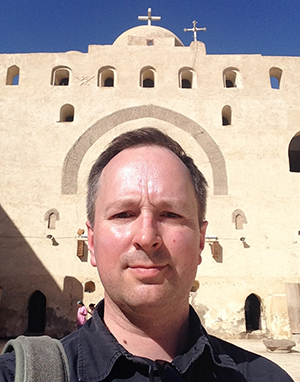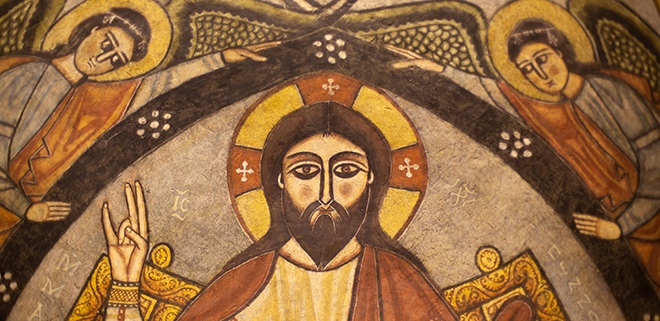Every year, the EU allocates project grants to top researchers in Europe through the European Research Council. This year's Consolidator Grants were announced on 10 December, and on the exclusive list of projects that have received funding, we find the project Storyworlds in Transition: Coptic Apocrypha in Changing Contexts in the Byzantine and Early Islamic Periods (APOCRYPHA), led by Professor Hugo Lundhaug.
Facts about the grant:
Consolidator Grants (CoG) are awarded by the European Research Council (ERC). The APOCRYPHA project will run over five years, and the grant from the ERC amounts to a total of 2 million Euros. The project will employ three postdoctoral fellows for three years each, and one PhD research fellow, in addition to Lundhaug himself as principal investigator (PI) leading the project. The project will begin in August 2020.
The grant awarded to Lundhaug is prestigious. To apply for a so-called Consolidator Grant you must have between seven and twelve years of research experience after receiving your doctoral degree. Applicants must have shown great potential as researchers and their research projects must satisfy very stringent requirements. This year, a record total of five projects at the University of Oslo received this grant (out of a total of eight in Norway as a whole).
Despite the fact that the eye of the needle is narrow, this is the second time Professor Lundhaug has received project funding from the EU. With a so-called ERC Starting Grant, he conducted the research project called New Contexts for Old Texts: Unorthodox Texts and Monastic Manuscript Culture in Fourth and Fifth-Century Egypt (NEWCONT), which was completed in 2016.
Dean Aud V. Tønnessen says she is very happy about this grant.
‘First and foremost, I would like to congratulate Hugo Lundhaug on the project grant. The effort behind it is impressive, and it takes a lot of hard work to meet the requirements for getting an ERC grant.’
‘This is of great importance to the faculty and the University of Oslo. It contributes profoundly to the development of the faculty and to strengthening our international position as an outstanding research institution’, Tønnessen says.
Rector Svein Stølen of the University of Oslo says he is particularly pleased that the awards demonstrate that UiO is a very strong breadth university, with five Consolidator Grants to five different faculties.
‘The ERC grants are very prestigious, and that UiO has now hit an "all time high" in the number of grants received tells me that we have outstanding scholars who are successful and who are getting good help from our research administration’, Stølen says.
In this round, ERC has awarded more than 600 million Euros across Europe. Further information can be found on ERC’s web pages.
Extensive era
In the new project, Lundhaug and his team will examine all known Coptic apocrypha in the period when Coptic was in use as a literary language in Egypt, from the 4th to the 12th century AD and beyond.
In other words, we are talking about nearly 1,000 years of literary history.
‘We will look at more than 100 different apocryphal works; that is, texts that elaborate on characters and events from the Bible and that are often attributed to apostles, evangelists, or other eyewitnesses. This literature was very popular in Egypt and, according to all indications, had a great influence on the worldview of Egyptian Christians’, Lundhaug says.
‘Some of the works are attested to in only one manuscript, but most of them are attested in several, albeit usually fragmentary, Coptic manuscripts.’

Lundhaug explains that the research project will ascertain how this literature evolved over nearly 1,000 years of Egyptian history, through dramatically changing historical, societal and religious contexts. The project will examine the production, use and transmission of apocryphal literature in Coptic in light of these changing contexts.
‘We will look at how the apocrypha developed as literature over time and how the texts and traditions changed as they were handed down. Many of the same themes recur in several different texts, but are adapted to changing circumstances’.
He says that his team will look in detail at how these changes relate to the societal and religious changes in Egypt during this period, an era in which Christianity goes from being the dominant religion in Egypt to becoming a minority religion in relation to Islam after the Arab conquest of Egypt in the seventh century, and in which even the Coptic language eventually had to yield to Arabic.
The project is methodologically innovative and combines perspectives and approaches from literary theory, cognitive science, media studies and material philology. The project also has a significant digital-humanities component that will be very important in the analytical work.
Comprehensive application process
Lundhaug got the idea for this project while managing his previous major research project (NEWCONT), also funded by the ERC, which dealt with manuscript culture and literature in the early stages of Egyptian monasticism. The idea for the new project was developed over several years.
The application that needs to be written is very comprehensive, and is evaluated in two rounds by an interdisciplinary pan-European panel of between 10-16 experts as well as a number of external peer reviewers (there is a total of 25 panels covering practically all academic fields in the humanities, social sciences, life sciences, physical and engineering sciences). In the first round, a short version of the proposal is assessed, while for those who progress to the second round the entire application is reviewed and an interview with the applicant is conducted in Brussels.
ERC grants have "Scientific Excellence" as their sole criterion and it is applied to the evaluation of the applicant and the project alike. In other words, they place very high demands on the quality of the Principal Investigator and the research to be carried out in the projects that receive financial support.
The grants are substantial and provide great opportunities for excellent researchers across Europe. ‘In receiving this grant, I have the opportunity to put together a team and conduct far more extensive and thorough research than I could have done by myself. An ERC grant gives the opportunity to pursue research questions that would otherwise not have been feasible. Without such funding, it would have been impossible for me to carry out a large-scale project like this.’
Will be hiring additional researchers
The project and the research to be carried out require an entire research team.
‘I am very much looking forward to getting the project team in place and starting the research; it will be really fun!’
The project involves a significant bolstering of the already strong Coptic-studies environment both locally at the faculty and nationally.
‘We will continue to host workshops and conferences where we invite an international research community to the faculty, as we have done since the start of the previous ERC-supported NEWCONT project in 2012. Through the APOCRYPHA project, the faculty will continue to be an important international "hub" for research on Coptic manuscripts and literature. Through these two projects, the academic community at the faculty distinguishes itself as one of the international leaders in this field’, Lundhaug concludes.
